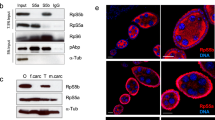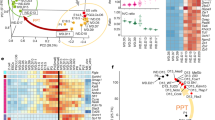Abstract
THE enzyme glucose phosphate isomerase (GPI; D-glucose-6-phosphate-ketol isomerase EC 5.3.1.9.) catalyses the interconversion of fructose-6-phosphate and glucose-6-phosphate. In mice, the product of the GPI structural gene is a monomer and the enzymatically active dimer results from monomer aggregation1,2. In inbred strains, GPI is found in either of two electrophoretically distinct forms: GPI-1AA or GPI-1BB (ref. 2). Theoretically, the random association of equal numbers of A and B monomers will result in dimers in the proportion of 25%AA:50%AB:25%BB, and indeed an activity distribution of these proportions is observed when samples of purified AA and BB forms, equal in enzymatic activity are dissociated and reassociated in vitro3. It follows, then, that (1) monomer aggregation is a random process which does not distinguish the monomer types; (2) the electrophoretic forms of GPI are similar enzymatically; (3) the measured activity is linearly proportional to the amount of enzyme. Therefore, the 25%AA:50%AB:25%BB activity distribution of GPI found in the mature tissues of heterozygous mice (Gpi-1a/b) (ref. 4) indicates that the a and b alleles are equally expressed. However, we show here that this is not the rule for unfertilised ova, for we have observed differences in the expression of GPI in unfertilised ova from the inbred mouse strains DBA/2J, LP/J and C57BL/6J. Mature somatic tissues do not reveal these interstrain differences. We postulate that the amount of GPI in ova is controlled by a cis-active regulator gene linked to the GPI structural locus. This is apparently the first characterisation of a genetic variation affecting the amount of an enzyme in the mouse ovum and it provides a unique opportunity for further exploration of gene regulation during mammalian development.
This is a preview of subscription content, access via your institution
Access options
Subscribe to this journal
Receive 51 print issues and online access
$199.00 per year
only $3.90 per issue
Buy this article
- Purchase on Springer Link
- Instant access to full article PDF
Prices may be subject to local taxes which are calculated during checkout
Similar content being viewed by others
References
Carter, N. D. & Parr, C. W. Nature 216, 511 (1967).
DeLorenzo, R. J. & Ruddle, F. H. Biochem. Genet. 3, 151 (1969).
Carter, N. D. & Yoshida, A. Biochim. biophys. Acta 181, 468–470 (1969).
Peterson, A. C., Frair, P. M. & Wong, G. Biochem. Genet, (in the press).
Paigen, K., Swank, R. T., Tomino, S. & Ganschow, R. E. J. Cell Physiol. 85, 379 (1975).
Sorensen, R. A. & Wasserman, P. M. Devl Biol. 50, 531–536 (1976).
Stevens, W. L. J. Genet. 43, 301–307 (1942).
Padua, R. A., Bulfield, G. & Peters, J. Biochem. Genet. 16, 127–143 (1978).
Epstein, C. L. Biol. Reprod. 12, 82–105 (1975).
Epstein, C. J. & Smith, S. A. Devl Biol. 33, 171–184 (1973).
Brinster, R. L. J. Reprod. Fert. 17, 139–146 (1968).
Chapman, V. M., Whitten, W. K. & Ruddle, F. H. Devl Biol. 26, 153–158 (1971).
Brinster, R. L. Biochem. Genet. 9, 187–191 (1973).
Author information
Authors and Affiliations
Rights and permissions
About this article
Cite this article
PETERSON, A., WONG, G. Genetic regulation of glucose phosphate isomerase in mouse oocytes. Nature 276, 267–269 (1978). https://doi.org/10.1038/276267a0
Received:
Accepted:
Issue Date:
DOI: https://doi.org/10.1038/276267a0
This article is cited by
-
Metabolic control of oocyte development: linking maternal nutrition and reproductive outcomes
Cellular and Molecular Life Sciences (2015)
-
High activity of an unstable form of glucose phosphate isomerase in the mouse
Biochemical Genetics (1987)
-
Variations in the amount of glucose phosphate isomerase in lymphocytes and erythrocytes from A/J and C57BL/6J mice
Biochemical Genetics (1985)
-
Glucosephosphate isomerase (GPI-1) expression in mouse ova: cis regulation of monomer realization
Biochemical Genetics (1985)
-
Location of structural genes for glucose phosphate isomerase and for leucyl aminopeptidase on chromosome VII of Petunia
Theoretical and Applied Genetics (1982)
Comments
By submitting a comment you agree to abide by our Terms and Community Guidelines. If you find something abusive or that does not comply with our terms or guidelines please flag it as inappropriate.



